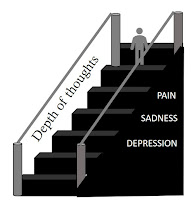Ever wondered what it is in pain and agony that stirs creativity in humans?
Why are most great artists, poets, writers, and musicians the ones who have suffered from depression?
Why do we better understand song lyrics when we are sad?
Why do we write or draw better when we're in pain?
What is it in pain that provides extra depth and dimensions to our thoughts, making the outcomes generated by such a mind much more aesthetic?
To do any task at hand, what we require is complete attention towards it. Attention is controlled by specific region of brain called Locus cerulus. As we grow this control becomes all the more absolute, so unless this brain center is engaged we cannot pay attention to a task. What controls this center is the reward pathway, which makes us more attentive towards things that activate our nucleus accumbens (reward center of brain). Thus, there exists a bidding inside our brain for attention, whichever task gives the most reward would win the attention and the attention center in turn.
Let's see how we behave in different emotional states. Although, each person would behave in a different manner, but some of the below paths might seem to be possible in majority of individuals.
In say a normal state, which is devoid of any emotions, the basal level of activity is achieved by our minds. We give our best to whatever task we set our attention to.
In a happy or excited state, our minds are a little distracted. We keep on thinking about the stuff that makes us happy, as it is a rewarding and pleasurable state. In excitation, again the mind keeps wandering to the reason behind that excitement.
When sad, and especially when we are lost how to best describe our pain and when direct words fail we look for alternate ways of expression. It is in these times as our minds are fixated on a single task, we do better than even our best.
Although, all the studies that have been performed so far to pinpoint the direct effect of mood on creativity have obtained contradictory results. While some found that positive mood like a state of happiness and elation enhance creativity, others saw similar results for sadness and depression. Amongst these one study stands out, which highlighted the dymanic role of emotions and found how exposure to negtiave mood followed by positive mood lead to extraordinary burst of creativity. Why haven't the researchers found a link between sadness and creativity?
1. Not everyone would be utilizing their mental agony to creative pursuits.
Although, all the studies that have been performed so far to pinpoint the direct effect of mood on creativity have obtained contradictory results. While some found that positive mood like a state of happiness and elation enhance creativity, others saw similar results for sadness and depression. Amongst these one study stands out, which highlighted the dymanic role of emotions and found how exposure to negtiave mood followed by positive mood lead to extraordinary burst of creativity. Why haven't the researchers found a link between sadness and creativity?
1. Not everyone would be utilizing their mental agony to creative pursuits.
People who use creative outlets to express their emotions can train their mind to create neuronal networks in their brain wherein the sadness can keep their attention to creating stories or paintings or music. It's like their attention is then wholly devoted to creating in the attempt to escape from the real world generated emotions. Most of us use entertainment to escape the reality, but there are people who find an escape in creating and these are the ones that have learnt to use their pain to paint the most stunning of paintings or to weave words in magical stories. So, it all comes down to how you train your mind.
2. The measures of creativity would be relative for each individual.
Not everyone is as creative to the same extent and creativity for each person is reflected in different aspects and tasks. The best approach is to measure the level of creativity for the same person under different emotional states. Comparing different individuals and with a reference level of creativity would not show the true effect. It is a generalized effect whose level would be different amongst different individuals.
3. We still do not know the brain pathways and specific brain regions that are involved in generating creativity.
Recent studies have been uncovering specific brain regions and pathways that work together to generate creativity. Maybe we require not to find a neural network with physical location in the brain, but another approach to study the workings of creative thoughts at the cognitive level.
You can read more about factors that affect creativity:
and the anatomical correlates of creativity in the brain:



This is so well put!
ReplyDeleteThank you. :)
Delete